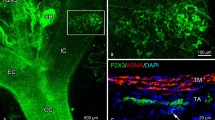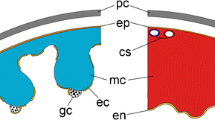Summary
Horseradish peroxidase (HRP)-conjugated α-bungarotoxin (αBgt) was used to localize αBgt-acetylcholine receptor sites in the rat carotid body. Two types of glomus cell were differentiated on the basis of the staining of their plasma membranes by the conjugate: type A, devoid of staining or only partly stained; and type B, exhibiting staining over the entire cell surface. The parts of type A glomus and supporting cells stained were always in direct apposition to type B glomus cells. It is concluded that type B glomus cells are possibly the only cell types exhibiting specific binding sites of αBgt. Other morphological characteristics and quantitative studies indicated that the type A and type B glomus cells presented in this study were equivalent to those described in the rat carotid body by other investigators (McDonald & Mitchell, 1975). αBgt-HRP staining facilitated the observation of the distribution pattern of glomus cells in the parenchyma: type A glomus cells were arranged in groups and often showed polarity toward neural elements and sinusoidal capillaries; and clusters of type B glomus cells were frequently situated in a demilune-like fashion over groups of type A glomus cells. Because of differences in morphology, synaptology, αBgt-binding affinity, and polarity toward the blood vessels, we propose that type A and type B glomus cells in the rat carotid body represent functionally distinct cell types.
Similar content being viewed by others
References
Abbott, C. P., Daly, M. De B. &Howe, A. (1972) Early ultrastructural changes in the carotid body after degenerative section of the carotid sinus nerve in the cat.Acta anatomica 83, 161–85.
Ballard, K. J. &Jones, J. V. (1971) The fine structural localization of cholinesterases in the carotid body of the cat.Journal of Physiology 219, 747–53.
Ballard, K. J. &Jones, J. V. (1972) Demonstration of choline acetyltransferase activity in the carotid body of the cat.Journal of Physiology 227, 87–94.
Chen, I-Li, Mascorro, J. A., Lumsden, P. W. &Yates, R. D. (1981a) Localization of alpha- bungarotoxin binding sites in the rat carotid body using horseradish peroxidase-conjugated toxin.39th Proceedings of Electron Microscope Society, of America (edited byBailey, G. W.), Vol. 39, pp. 488–89. Baton Rouge: Claitor's Publishing Division.
Chen, I-Li, Mascorro, J. A. &Yates, R. D. (1981b) Autoradiographic localization of α-bungarotoxin-binding sites in the carotid body of the rat.Cell and Tissue Research 219, 609–18.
Cocchia, D. &Fumagalli, L. (1981) Immunocytochemical localization of α-bungarotoxin receptors in the chick ciliary ganglion: synaptic and extrasynaptic sites?Neurochemistry International 3, 123–28.
Dinger, B., Gonzalez, C., Yoshizaki, K. &Fidone, S. (1981) Alpha-bungarotoxin binding in cat carotid body.Brain Research 205, 187–93.
Eyzaguirre, C. &Fidone, S. J. (1980) Transduction mechanisms in carotid body: glomus cells, putative neurotransmitters, and nerve endings.American Journal of Physiology 239, C135-C151.
Eyzaguirre, C. &Zapata, P. (1968) The release of acetylcholine from carotid body tissues. Further studies on the effects of acetylcholine and cholinergic blocking agent on the chemosensory discharge.Journal of Physiology 195, 589–607.
Fidone, S. J., Weintraub, S. T. &Stavinoha, W. B. (1976) Acetylcholine content of normal and denervated cat carotid bodies measured by pyrolysis gas chromatography/mass fragmentometry.Journal of Neurochemistry 26, 1047–49.
Fidone, S., Weintraub, S., Stavinoha, W., Stirling, C. &Jones, L. (1977) Endogenous acetylcholine levels in cat carotid body and the autoradiographic localization of high affinity component of choline uptake, InChemoreception in the Carotid Body (edited byAcker, H., Fidone, S., Pallot, D., Eyzaguirre, C., Lubbers, D. W. andTorrance, R. W.), pp. 106–13. New York, Heidelberg: Springer-Verlag.
Goldberg, A. M., Lentz, A. P. &Fitzgerald, R. S. (1978) Neurotransmitter mechanisms in the carotid body: Absence of ACh in the carotid sinus nerve.Brain Research 140, 374–77.
Grimley, P. M. &Glenner, G. G. (1968) Ultrastructure of the human carotid body. A perspective on the mode of chemoreception.Circulation 37, 648–65.
Hayashida, Y. &Eyzaguirre, C. (1979) Voltage noise of carotid body type I cells.Brain Research 167, 189–94.
Hellström, S. (1975) Morphometric studies of dense-cored vesicles in Type I cells of rat carotid body.Journal of Neurocytology 4, 77–88.
Höglund, R. (1967) An ultrastructural study of the carotid body of horse and dog.Zeitschrift für Zellforschung und mikroskopische Anatomie 76, 568–76.
Jacob, M. H. &Berg, D. K. (1983) The ultrastructural localization of α-bungarotoxin binding sites in relation to synapses on chick ciliary ganglion neurons.Journal of Neurosdence 3, 260–71.
Jones, J. V. (1975) Localization and quantitation of carotid body enzymes: Their relevance to the cholinergic transmitter hypothesis. InThe Peripheral Arterial Chemoreceptors (edited byPurves, M. J.), pp. 143–61. New York: Cambridge University Press.
Jones, J. V. &Ballard, K. J. (1971) Cholinesterases in the carotid body of the cat as seen with the electron microscope.Nature 233, 146–48.
Jones, S. W. &Salpeter, M. M. (1983) Absence of [125I]α-bungarotoxin binding to motor nerve terminals of frog, lizard and mouse muscle.Journal of Neurosdence 3, 326–31.
Kobayashi, S. (1968) Fine structure of the carotid body of the dog.Archivum Histologicum Japonium 30, 95–120.
Krammer, E. B. (1978) Carotid body chemoreceptor function: Hypothesis based on a new circuit model.Proceedings of the National Academy of Sciences USA 75, 2507–11.
Lentz, T. L. &Chester, J. (1977) Localization of acetylcholine receptors in central synapses.Journal of Cell Biology 75, 258–67.
Lentz, T. L. &Chester, J. (1982) Synaptic vesicle recycling at the neuromuscular junction in the presence of a presynaptic membrane marker.Neurosdence 7, 9–20.
Lentz, T. L., Mazurkiewicz, J. E. &Rosenthal, J. (1977) Cytochemical localization of acetylcholine receptors at the neuromuscular junction by means of horseradish peroxidase-labeled α-bungarotoxin.Brain Research 132, 423–42.
Lever, J. D., Lewis, P. R. &Boyd, J. D. (1959) Observation on the fine structure and histochemistry of the carotid body in the cat and rabbit.Journal of Anatomy 93, 478–96.
Lowry, O. H., Rosenbrough, H. J. &Randall, R. J. (1951) Protein measurement with the folin phenol reagent.Journal of Biological Chemistry 19, 265–75.
Marshall, L. M. (1981) Synaptic localization of α-bungarotoxin binding which blocks racotinic transmission at frog sympathetic neurons.Proceedings of the National Academy of Sciences USA 78, 1948–52.
McDonald, D. M. (1980) Regulation of chemoreceptor sensitivity in the carotid body: the role of presynaptic sensory nerves.Federation Proceedings 39, 2627–35.
McDonald, D. M. &Mitchell, R. A. (1975) The innervation of glomus cells, ganglion cells and blood vessels in the rat carotid body: A quantitative ultrastructural analysis.Journal of Neurocytology 4, 177–230.
Matsumoto, S., Nakajima, T., Uchida, T., Ozawa, H. &Ushiyama, J. (1982) Effects of sodium cyanide, dopamine and acetylcholine on the resting membrane potential of glomus cells in the rabbit.Brain Research 239, 674–78.
Morita, E., Chiocchio, S. R. &Tramezzani, J. H. (1969) Four types of main cells in the carotid body of the cat.Journal of Ultrastructure Research 28, 399–410.
Morita, E., Chiocchio, S. R. &Tramezzani, J. H. (1970) The carotid body of the Weddel seal (Leptonychotes weddelli).Anatomical Record 167, 309–28.
Novikoff, A. B., Novikoff, P. M., Quintana, N. &Davis, C. (1972) Diffusion artifacts in 3,3′-diaminobenzidine cytochemistry.Journal of Histochemistry and Cytochemistry 20, 745–49.
Oswald, R. E. &Freeman, J. A. (1981) Alpha-bungarotoxinbinding and central nervous system nicotinic acetylcholine receptors.Neurosdence 6, 1–14.
Verna, A. (1977) Dense-cored vesicles and cell types in the rabbit carotid body. InChemoreception in the Carotid Body (edited byAcker, H., Fidone, S., Pallot, D., Eyzaguirre, C., Lübbers, D. W. andTorrance, R. W.), pp. 216–20. New York: Springer-Verlag.
Verna, A. (1979) Ultrastructure of the carotid body in mammals.International Review of Cytology 60, 271–330.
Vogel, Z., Towbin, M. &Daniels, M. P. (1979) Alpha-bungarotoxin-horseradish peroxidase conjugate. Preparation, properties and utilization for the histochemkal detection of acetylcholine receptors.Journal of Histochemistry and Cytochemistry 27, 846–51.
Woods, R. I. (1975) Penetration of horseradish peroxidase between all elements of the carotid body. InThe Peripheral Arterial Chemoreceptors (edited byPurves, M. J.), pp. 195–205. New York: Cambridge University Press.
Author information
Authors and Affiliations
Rights and permissions
About this article
Cite this article
Chen, I.L., Yates, R.D. Two types of glomus cell in the rat carotid body as revealed by α-bungarotoxin binding. J Neurocytol 13, 281–302 (1984). https://doi.org/10.1007/BF01148120
Received:
Revised:
Accepted:
Issue Date:
DOI: https://doi.org/10.1007/BF01148120




